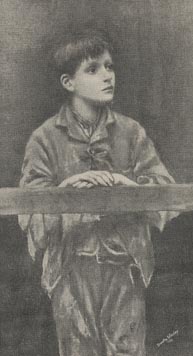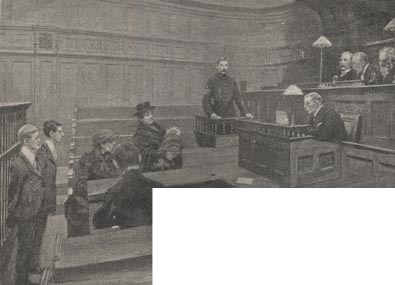Poverty and Juvenile Crime - PrisonsThis is the second part an article by Barbara Daniels
on juvenile crime in Victorian Britain. It looks at prisons and the
sort of treatment child prisoners received.
Prison before trial When a child was caught in criminal activity they would be put into prison until such time as they could come before the courts to be tried and sentenced. There was quite a lot of protest about this. In February 1847 Sir J. Pakington spoke in Parliament about the practice of putting children in prison awaiting trial. He cited two cases:
These children were, he said, exposed to all kinds of contamination, moral and physical whilst they were locked up with hardened criminals. Bill for the Correction and Reformation of Juvenile OffendersIn March 1850 a Bill was put before Parliament to try to change the law. It was called the Bill for the Correction and Reformation of Juvenile Offenders. This proposed that for the first offence by children of vagrancy and larceny, boys were to be whipped and girls to be reprimanded. If the parents could be found they were to be fined between £2 and £10. This punishment was to take effect as soon as the child was caught and so avoid them being put in prison. (2) Punishment for theftAn example of the punishment given to young criminals was reported in January 1846. Four boys were convicted of theft and given one months imprisonment. At the end of the sentence they were to be whipped with a birch rod. The journalist who reported this case wrote: 'Twenty-eight days and nights of painful apprehension to be followed by what occasions "the utmost horror" is a curious specimen of quarter sessions 'leniency'. The reporter was making a comment on the fact that the jury had recommended leniency when dealing with the young wrongdoers. The boys lived in very overcrowded areas, which were said to be 'academies for juvenile convicts'. In other words the only way of life they were likely to learn was a criminal one' (3). Picking oakumOnce in prison various forms of punishment were available to keep the prisoners occupied. Many children were made to 'pick oakum' for up to five hours a day. This meant 'the pulling to pieces of old tarry ropes' (4) which were then used to make new ropes or to cover the planks of wooden ships to make them water tight. This made their hands very sore. The treadmillThe Treadmill was 'a big iron frame of steps around a revolving cylinder'. In the early part of the century prisoners were put on the treadmill for up to six hours a day. It had no useful purpose. It was just monotonous hard work. In 1843 the Prison Inspectors' General Survey stated that the treadmill was 'an improper punishment for females and boys under 14 years of age'.(5) The crankUntil 1865 other forms of hard labour included the crank 'which was a wheel with a counting device fitted into a box of gravel'. (6) The prisoner turned the handle for a given number of rotations and this moved the gravel around in the box . This was another useless activity. In Leicester prison a certain number of cranks had to be turned before any food or drink was made available. In Birmingham if the prisoner had not completed the required number he was kept in the crank cell until late in the night. This meant he would miss supper and have no food until the next morning. StraitjacketsBecause many prisoners could not turn the crank as required a straitjacket was introduced. The prisoner was put in this and strapped to the wall of his cell in a standing position for up to four to six hours. This punishment was chiefly used on boys. If they fainted a bucket of water was thrown over them. The straitjacket was used on children as young as ten. Solitary confinement and food restrictionsIf a child misbehaved whilst in prison they were punished by being put on a diet of bread and water. They were sometimes put in solitary confinement. For continued misdemeanours they were put in a dark cell with hardly any furniture and totally without light.
Parkhurst PrisonParkhurst prison on the Isle of Wight was opened in 1838. It had a wing
for young offenders, but only those boys who had been sentenced to transportation
to the colonial prisons were sent there. In 1848 a correspondent wrote to The Times citing the case of an eight-year old boy who had been sent to Parkhurst. This person thought that it was wrong that the courts had only two options for this young boy. They could either put him to hard labour in prison or sentence him to transportation (7) . However life was not easy in the prison, especially if the young prisoner did not conform to all the rules. Here is a list of the punishments meted out during one year: '165 whippings, 44 confinements in the black-hole, 614 solitary confinements with bread and water, 3,248 bread and water for single meals without confinement and 35 in the penal class.' (8) ReformThere were many people who thought that prison was not the answer and certainly that children should not be treated in the same way as adults. They needed to be given an education and taught a trade and helped to earn their living honestly, otherwise they had no option but to go back to their old ways as soon as they were released. Children getting involved in crime after leaving children's homes was a big
concern for organisations that ran such homes. That was one of the reasons the
Waifs and Strays Society took to care to ensure that children had training,
education and were given assistance in getting employment when they left its
care. References1. The Times, 24 February 1847 (p. 4 col. b) |





